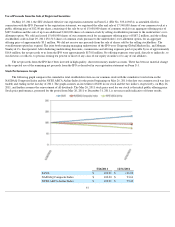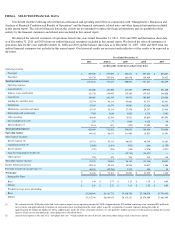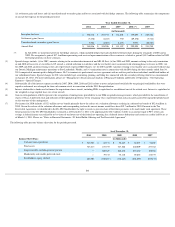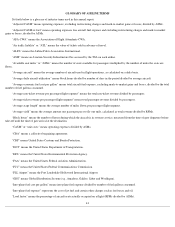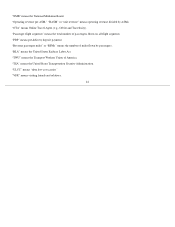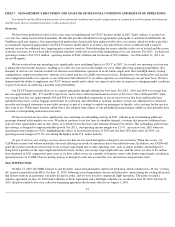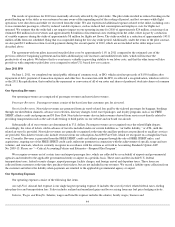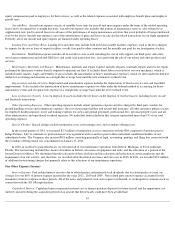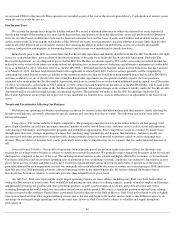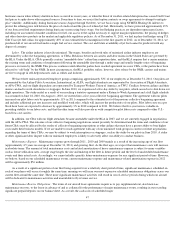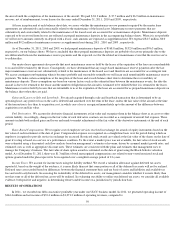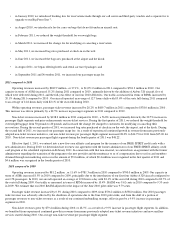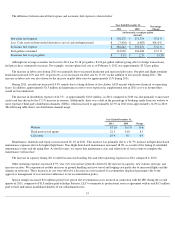Spirit Airlines 2011 Annual Report Download - page 53
Download and view the complete annual report
Please find page 53 of the 2011 Spirit Airlines annual report below. You can navigate through the pages in the report by either clicking on the pages listed below, or by using the keyword search tool below to find specific information within the annual report.
we not made PDPs for that aircraft. These amounts are recorded as part of the cost of the aircraft upon delivery. Capitalization of interest ceases
when the asset is ready for service.
Our Income Taxes
We account for income taxes using the liability method. We record a valuation allowance to reduce the deferred tax assets reported if,
based on the weight of the evidence, it is more likely than not that some portion or all of the deferred tax assets will not be realized. Deferred
taxes are recorded based on differences between the financial statement basis and tax basis of assets and liabilities and available tax loss and
credit carryforwards. In assessing the realizability of the deferred tax assets, our management considers whether it is more likely than not that
some or all of the deferred tax assets will be realized. In evaluating the ability to utilize our deferred tax assets, we consider all available
evidence, both positive and negative, in determining future taxable income on a jurisdiction by jurisdiction basis.
Immediately prior to the IPO, we entered into the Tax Receivable Agreement and thereby distributed to the Pre-IPO Stockholders the right
to receive such stockholders’ pro rata share of the future payments to be made by us under the Tax Receivable Agreement. Under the Tax
Receivable Agreement, we are obligated to pay to the Pre-IPO Stockholders an amount equal to 90% of the cash savings in federal income tax
realized by us by virtue of our future use of the federal net operating loss, deferred interest deductions and alternative minimum tax credits held
by us as of March 31, 2011, which we refer to as the Pre-IPO NOL. “Deferred interest deductions” means interest deductions that have accrued
as of March 31, 2011, but have been deferred under rules applicable to related party debt. Cash tax savings generally will be computed by
comparing our actual federal income tax liability to the amount of such taxes that we would have been required to pay had such Pre-IPO NOLs
not been available to us. As of the effective date of the Tax Receivable Agreement, we recognized a liability equal to the total payments
estimated to be made under the Tax Receivable Agreement, which are accounted for as a reduction of additional paid-
in capital. As of December
31, 2011, we estimate a cash benefit of $36.5 million , or 90% of the total cash benefit from the full use of the Pre-IPO NOLs, will be paid to the
Pre-
IPO Stockholders under the terms of the Tax Receivable Agreement. Subsequent changes in the estimated liability under the Tax Receivable
Agreement will be recorded through earnings in operating expenses. The payments we make to the Pre-IPO Stockholders under the Tax
Receivable Agreement are not expected to give rise to any incidental tax benefits to us, such as deductions or an adjustment to the basis of our
assets.
Trends and Uncertainties Affecting Our Business
We believe our operating and business performance is driven by various factors that affect airlines and their markets, trends affecting the
broader travel industry, and trends affecting the specific markets and customer base that we target. The following key factors may affect our
future performance.
Competition . The airline industry is highly competitive. The principal competitive factors in the airline industry are fare pricing, total
price, flight schedules, aircraft type, passenger amenities, number of routes served from a city, customer service, safety record and reputation,
code-sharing relationships, and frequent flier programs and redemption opportunities. Price competition occurs on a market-by-market basis
through price discounts, changes in pricing structures, fare matching, target promotions and frequent flier initiatives. Airlines typically use
discount fares and other promotions to stimulate traffic during normally slower travel periods to generate cash flow and to maximize unit
revenue. The prevalence of discount fares can be particularly acute when a competitor has excess capacity that it is under financial pressure to
sell.
Seasonality and Volatility . Our results of operations for any interim period are not necessarily indicative of those for the entire year
because the air transportation business is subject to significant seasonal fluctuations. We generally expect demand to be greater in the second and
third quarters compared to the rest of the year. The air transportation business is also volatile and highly affected by economic cycles and trends.
Consumer confidence and discretionary spending, fear of terrorism or war, weakening economic conditions, fare initiatives, fluctuations in fuel
prices, labor actions, weather and other factors have resulted in significant fluctuations in revenues and results of operations in the past. In
particular, demand for air transportation services was materially adversely affected by the severe economic recession starting in 2008, and record
high fuel prices in 2008 materially adversely affected operating results in the industry generally. We believe demand for business travel
historically has been more sensitive to economic pressures than demand for low-price travel.
Aircraft Fuel . Fuel costs represent the single largest operating expense for most airlines, including ours. Fuel costs have been subject to
wide price fluctuations in recent years. Fuel availability and pricing are also subject to refining capacity, periods of market surplus and shortage,
and demand for heating oil, gasoline and other petroleum products, as well as meteorological, economic and political factors and events
occurring throughout the world, which we can neither control nor accurately predict. We source a significant portion of our fuel from refining
resources located in the southeast United States, particularly facilities adjacent to the Gulf of Mexico. Gulf Coast jet fuel tends to sell at slightly
lower prices than fuel from other regional refining sources due to the size and depth of the market, and we believe this difference gives us an
advantage on our largest single operating cost. At the same time, however, Gulf Coast fuel is subject to volatility and supply disruptions,
particularly in
46


